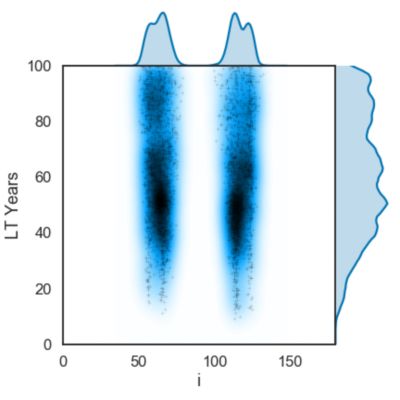-
United States -
United Kingdom -
India -
France -
Deutschland -
Italia -
日本 -
대한민국 -
中国 -
台灣
-
Ansysは、シミュレーションエンジニアリングソフトウェアを学生に無償で提供することで、未来を拓く学生たちの助けとなることを目指しています。
-
Ansysは、シミュレーションエンジニアリングソフトウェアを学生に無償で提供することで、未来を拓く学生たちの助けとなることを目指しています。
-
Ansysは、シミュレーションエンジニアリングソフトウェアを学生に無償で提供することで、未来を拓く学生たちの助けとなることを目指しています。
ANSYS BLOG
March 17, 2023
GEO Satellites Don’t Decay in 38 Years, Do They?
Do GEO satellites decay in less than four decades? The answer depends on if you define GEO as “geostationary orbit” or “geosynchronous orbit.” If you think of GEOs as orbits near the equator with a small inclination, then no, your satellite will not decay within 40 years, or anytime soon thereafter, for that matter. But if your definition of GEO encompasses any geosynchronous orbit, such as an orbit that happens to be within about 15 degrees of the critical inclinations, your satellite may reenter a lot sooner than expected.
Ansys Systems Tool Kit (STK) has a tool — called the Lifetime tool — that you can use to predict orbital lifetimes. Using an example GEO orbit, the Lifetime tool predicted it would decay in 38 years. STK's High-precision Orbit Propagator (HPOP) verified this seemingly strange behavior. HPOP modeled that it actually took 68 years for the satellite to reenter, but there was a near reentry at the 38-year mark — just as the Lifetime tool predicted.
This “early reentry” phenomenon is not specific to GEOs. It can occur to most orbit regimes above low Earth orbits (LEO). Below, you can see a plot of the lifetime predictions versus inclination for randomized orbits with radii between 10,000 km and 44,000 km. Only the orbits that decayed within 100 years are plotted. The plot shows that all the orbits that decayed were near the two critical inclinations of 63.4 and 116.6 ± 14 degrees.

At these critical inclinations, the satellite’s perigee location doesn’t experience much drift due to Earth’s oblateness. This leads to stability in orbit orientation. Because of this stability, a situation can arise in which the satellite is pulled by the Moon and Sun more strongly on one side of the orbit than on the other. These perturbations will cause the eccentricity to grow even as the satellite maintains the same orbital energy. That is, until the perigee gets pulled into the Earth.
You may be thinking: “If some of these orbits are decaying, how common is this?” The plot below addresses this question by using satellites at different altitudes, but within about five degrees of the 63.4-degree critical inclination.

Surprisingly, as the periapsis radius increases so does the chance of decaying. About 50% of orbits with a radius of periapsis greater than 35,000 km end up decaying in less than 100 years. This led me to wonder if this orbit regime could be used as an end-of-life decay orbit.
Typically, GEOs are disposed of by moving them into supersynchronous orbits. This approach takes about 10 m/s of Delta-V. But this leaves the satellite in orbit nearly indefinitely. To deorbit a GEO by lowering the satellite’s perigee into Earth’s atmosphere, you need a much larger Delta-V of about 1,480 m/s. This amount of Delta-V could also be used for an inclination change of up to 28 degrees. If a complete deorbit was preferable, it may be cheaper for a geosynchronous satellite with an inclination above 30 degrees to raise its inclination and let the orbit naturally decay, rather than perform a large altitude lowering maneuver. This is not practical for most GEOs, and there is collision risk whenever a defunct satellite’s orbit naturally decays.
But for a few unique missions, this could make sense. For a mission in an orbit like Japan’s QZSS satellites — which are at an inclination of 43 degrees — it would take 530 m/s of Delta-V to raise the inclination by 10 degrees. That might just be enough to allow the orbit to decay naturally with a hundred years. This is still a much higher Delta-V than would be required to move the satellite to a supersynchronous orbit, but it would offer the benefit of removing space debris.
For more information on this GEO example, orbital lifetime predictions in general, and how to set up your own large-scale orbital lifetime analysis, check out this code example on our GitHub.
To learn more about how Ansys STK can help you plan lunar missions, visit our digital mission engineering page.










